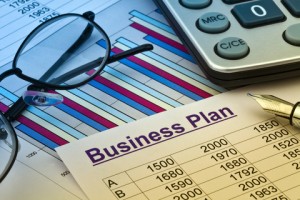 When coming up with a business plan for your new venture, one of the more important tasks you will face is creating financial predictions for your business. Without solid, believable financial forecasts, you’ll find it difficult to secure loans or investors.
When coming up with a business plan for your new venture, one of the more important tasks you will face is creating financial predictions for your business. Without solid, believable financial forecasts, you’ll find it difficult to secure loans or investors.
Making financial predictions for your new venture mostly consists of estimating how much you will spend and how much you will earn, and using these estimates to determine whether your business will be a worthwhile venture.
Creating financial forecasts for your business will help you attract investors and also give you the knowledge and confidence you need to believe that your business will be profitable. If your early projections for your business show that it will be a money-losing venture, you can make adjustments to your business plan such as cutting costs or raising prices to change the numbers. By ironing out potential difficulties early by careful planning, you increase your business’ chance of success.
When running the financials for your business plan, you’ll need to estimate a break-even point, forecast your profit and loss, estimate your start-up costs and project your cash flow.
Break-Even Point
Your break-even analysis shows how much money you need to make to at least break even. You’ll evaluate your estimated income and expenses for a given period (usually a year or more) and determine whether your business can turn a profit.
To determine your break-even point, you’ll need to estimate how much of each product or service you’re selling that you’ll be able to sell in one year. You’ll also need to determine a gross profit percentage from each profit you sell. This is done by subtracting the costs of each product or service from the price you’re charging. Your gross profit percentage measures how much money you make after the costs involved with providing your products or services to customers.
Once you’ve determined your gross profit percentage, you then need to determine your fixed costs, such as rent and insurance. Once that’s done, a few simple calculations will help you determine if your profits will at least cover your expenses.
For example, let’s say John is starting a home-based carpentry business selling chairs. John estimates that he will be able to sell 12 chairs per month at $50 each, bringing in a yearly income of $7,200. The materials for each chair cost John about $15 each, leaving John with about $35 in profit from each sale.
To calculate his gross profit percentage, John should divide his gross profit, $35, by his selling price, $50. The result is 70 percent, meaning that 70 cents of every sale dollar John makes exceeds the cost of the chairs he’s selling.
Next, John will need to determine his fixed costs, which in this case are the costs of his tools and utilities for his shop located in his garage. John estimates these costs to be about $30 per month, or $360 per year.
To arrive at his break-even point, John will now need to divide his annual fixed costs of $360 by his gross profit percentage. The result is about $514 – the amount John needs to earn per year to cover his fixed costs and material expense. All money earned above that amount are John’s pretax profits. Because John estimates he’ll earn about $7,200 per year in chair sales, he’ll easily hit his break-even point and make nearly $6,800 in pretax profits – not bad for a part-time, beginning home business.
This, of course, is a highly simplified version of finding your gross profit percentage and break-even point. As most businesses sell more than one product or service, business owners will need to determine an average gross profit for all products. To find this number, begin by dividing your products and services into categories. For example, if you’re selling furniture, you may want to divide products into chairs, tables, stools, etc.
Once this is done, you’ll want to determine the average selling price and average variable cost for each category. Once that’s done, subtract the average variable cost from your products average selling price in each product or service category to determine your average gross profit for each category of products or services.
When you’ve completed this, you can determine your average gross profit. Estimate your annual sales in each category of products or services. Once that’s done multiply your estimated sales revenue by the gross profit percentage you calculated according to the preceding paragraph. When you’ve completed this, add each sum together to calculate the total annual gross profit for your business.
Estimating Income and Costs
Before making your break-even analysis, you need to have a firm grip on your income and costs. Having an overly optimistic estimate of your income and expenses can throw your break-even point way off, and faulty financial forecasting can cause you serious problems when more-experienced eyes at a bank or other lender look at your business plan, or when you get your business off the ground and aren’t making enough money to cover your actual costs.
When estimating your costs, you need to determine your fixed and variable costs. Your fixed costs, also commonly known as overhead, include expenses that are not directly tied to the services or items you are selling. Costs such as rent, utilities, insurance, postage and most salaries are fixed costs.
Variable costs are costs directly tied to what you’re selling. These costs can include cost of materials, supplies, packaging and some labor costs. Typically, variable costs go up or down based on how much you’re selling, while fixed costs stay the same regardless of sales volume.
Labor can be tricky to define as fixed or variable. Typically, salaries that will always be necessary and do not fluctuate based on business volume, such as full-time permanent employees like a manager or bookkeeper, will be defined as fixed costs, whereas salaries that come and go based on how busy you are, such as temporary cashiers hired for the holiday season, are treated as variable costs.
When estimating your income, you’ll need to take into account how much you will sell each year and how much you will charge for your products and services. Your estimate will never be 100 percent accurate, but it is important to go for the closest estimate to actual performance you can get in order for you to come up with a realistic break-even analysis and other financial forecasts.
One way you can estimate your income is by comparing your business to similar ventures. Retail businesses often calculate their annual sales income per each square foot of retail space present in their stores. For example, if you wanted to open a nutrition supplement store, you’d need to find out the sales revenue per square foot of similar businesses. Your competitors won’t be lining up to give you this information, but industry trade publications can give you good estimates, or similar businesses outside your competition area may be more willing to provide the information.
When coming up with your break-even analysis, having a solid grip on your costs and revenues is key to having the most accurate financial picture possible. As mentioned before, having a reliable break-even analysis is vital to securing loans and to operating your business.
Forecasting Profit/Loss
If your break-even analysis shows that your business will be profitable, you’ll next need to come up with profit/loss forecasts. Your profit/loss forecast uses your sales revenue and variable costs to determine your gross profit, and then subtracts your fixed expenses from the gross profit figure to determine your net profit.
You profit/loss forecast differs from your break-even analysis in that it looks at monthly net profits, whereas the break-even analysis is a yearly snapshot of your profit and loss. The monthly view provided by the profit/loss forecast helps you better plan for burdens that may be imposed by slow or lean months in your business.
When breaking your break-even analysis into a profit/loss forecast, you must begin by translating your yearly sales estimate into monthly estimates. If sales are expected to vary from month to month, you should account for that fluctuation in your profit/loss forecasts.
When determining your gross profit for each month, the easiest method to use is multiplying each month’s sales revenue by the yearly gross profit percentage for your business. You’ll then need to add up your business’ monthly fixed expenses. Once that’s done, you’ll need to subtract your business’ monthly fixed expenses from its gross profit. The result is your net profit or loss.
The profit/loss forecast will outline the profitability of your venture on a monthly basis. Some months are likely to be more profitable than others, which may encourage you to try to increase sales or cut costs in those months. Don’t panic if you’re running at a loss in the early months of your business, as this is common. You can address the difficulties this may cause for your business by securing loans and credit to see you through the lean months until your business reaches profitability.
Estimating Start-Up Costs
Determining how much your start-up costs will be is another key part of drafting your business plan. While your profit/loss forecasts and break-even analysis describe your ongoing revenues and expenses, they do not take into account the costs that go into getting your business off the ground, such as deposits on leases, business licensing, the purchase of equipment and marketing materials, etc. These costs can be a hardship for new business owners because they must be purchased before the business is making any revenue.
Potential lenders and investors will want to see these items accounted for before they lend you money.
When starting a business, you’ll want to keep your start-up costs as low as you can. Purchase only items that are absolutely necessary to generate revenue. (For example, make do with secondhand office furniture for any office space that is out of your customers sight.)
If you don’t have the cash to cover your start up costs, you may need to find more affordable options, such as leasing your equipment or you may need to secure credit from a lender to cover your start-up needs. Having a good estimate of your start-up costs is helpful in convincing lenders and investors to put money into your business, as it shows you have considered your start-up needs and have a good estimate of their costs.
Projecting Cash Flow
Projecting cash flow is another important financial forecast you need to make when drafting your business plan or in planning for your established business’ future. While your profit/loss forecast can show whether your business can make the sales it needs to cover expenses, a cash flow projection shows whether you’ll make money quickly enough to pay your bills in a timely manner. Managing your cash flow is important once your business is established, as you’ll need a steady stream of income to meet monthly obligations such as buying inventory and paying bills. If you’re extending credit to customers, it’s also important to have adequate cash flow to cover expenses if some of them are late in repayment.
Cash flow projection is vital in helping you show investors and lenders, as well as yourself, your business partners and your family, how you intend to survive during your first months of business, which are typically very lean months. Most business owners must find a way to cover months of a cash deficit as they start their business ventures. One way to make cash flow a little easier is to get a start-up loan or by putting off or reducing some early expenses.
When creating your cash flow projection, you’ll use many of the same calculations you used to determine your profit/loss forecast. But instead of just using your sales revenues and expenses, you’ll use all of your inflows and outflows of cash. Also, instead of spreading costs out over 12 months, you’ll record them in the month in which they actually occur.
Some examples of cash inflows and outflows that should be included in your cash flow projection include start-up costs, loans and loan repayments. When your business starts turning a profit, you’ll need to include your income tax payments in the cash flow projection too, but for most estimates, chances are that you’ll be free of income taxes in your first year of operations.
To calculate your cash flow for each month, start with how much cash your business will have on hand and then report all inflows of cash – sales, loans, personal money, etc. Add these to your cash on hand to determine your cash-ins total for the month.
Next, you’ll need to determine your cash-outs. These include costs such as monthly fixed expenses and payments on loans. You’ll also need to include your variable costs – items such as materials for products or items you need to supply your services to customers.
Once you’ve tallied your cash-ins and cash-outs, you’ll need to subtract your cash-outs from your cash-ins to arrive at your cash balance for the next month. When you’ve completed 12 months worth of cash flow projection, you’ll have a good look at how your business will be doing financially each month. If you have some months where there are cash deficits, you’ll need to adjust your business plan to ensure that you’ll at least have enough cash to cover your essential expenses, meaning that you’ll have to move or reduce costs. Cash flow projections that show that you’ll have difficulty in meeting your financial obligations will be off-putting to investors and is evidence that you’ll need to revise your business plan.
By making reliable calculations of your cash flow, break-even point, profit/loss and fixed and variable costs, you have a better idea of what you will need to do to make your business profitable. You’re also armed with better information to present to potential lenders or investors. That’s why it’s well worth the time and effort to aquaint yourself with these concepts and do the number crunching necessary to develop reliable financial forecasting data.









